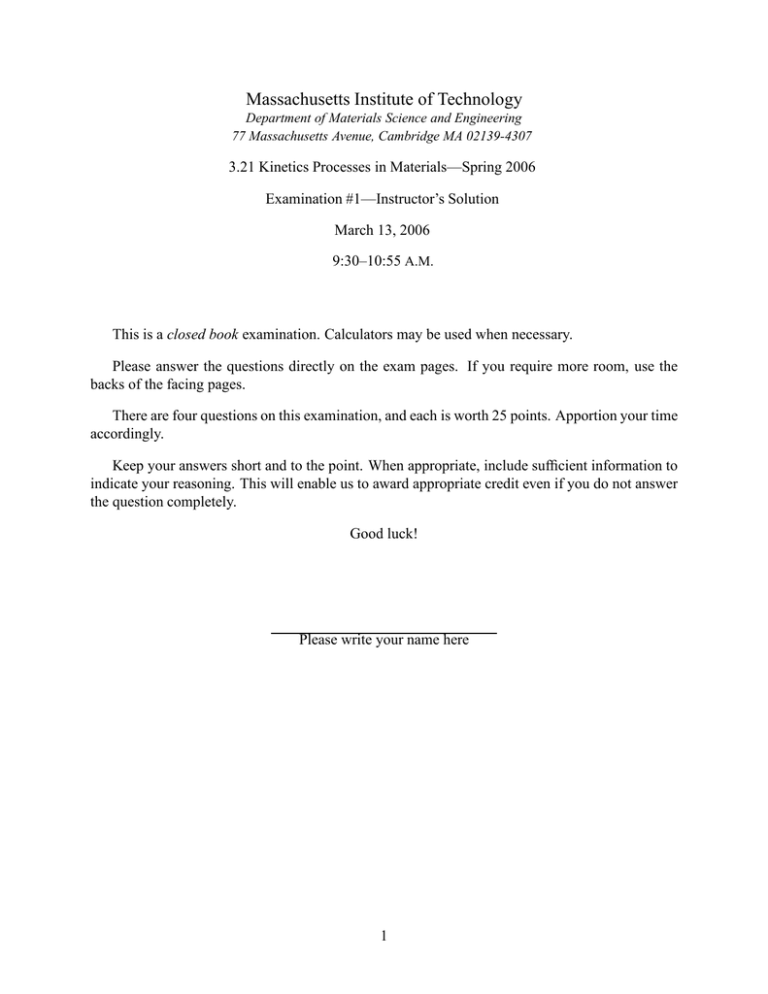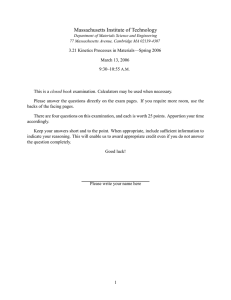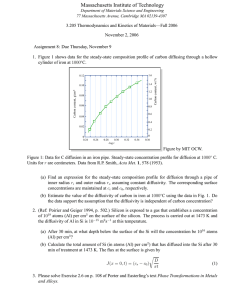Massachusetts Institute of Technology
advertisement

Massachusetts Institute of Technology Department of Materials Science and Engineering 77 Massachusetts Avenue, Cambridge MA 02139-4307 3.21 Kinetics Processes in Materials—Spring 2006 Examination #1—Instructor’s Solution March 13, 2006 9:30–10:55 A.M. This is a closed book examination. Calculators may be used when necessary. Please answer the questions directly on the exam pages. If you require more room, use the backs of the facing pages. There are four questions on this examination, and each is worth 25 points. Apportion your time accordingly. Keep your answers short and to the point. When appropriate, include sufficient information to indicate your reasoning. This will enable us to award appropriate credit even if you do not answer the question completely. Good luck! Please write your name here 1 1. When equilibrated at high temperatures, f.c.c. magnesium oxide (MgO) will have equal numbers of negatively charged cation vacancies and positively charged anion vacancies uni­ formly distributed throughout the material. By answering the questions below, describe what will happen to the equilibrium cation and anion vacancy distributions if an MgO crystal is placed in a uniform electric field. Assume that the total numbers of both kinds of vacancies remains constant. (a) Write the general equations for the coupled forces and fluxes in this problem. Note any constraints on the coefficients in your equations. � Solution: Assume that the electrostatic forces on the vacancies are equal to q∇φ = qE where q = ±2e. There will also be a diffusive force from any gradients of chemical potential. Vacancies and their associated charge move together. The flux equations for the cation and anion vacancies will be Jc = Lcc ∇(µc + 2eφ) + Lca ∇(µa − 2eφ) Ja = Lac ∇(µc + 2eφ) + Laa ∇(µa − 2eφ) (1) (2) From Onsager’s symmetry principle, Lca = Lac . (b) What is an appropriate diffusion potential for the species in this problem? Explain how the diffusion potential could be used to characterize the steady state that would be obtained by annealing in an electric field for a very long time. Solution. The diffusion potential must account for the combined effects of concentra­ tion gradients and electrical potential gradients. It will have the form shown in KoM Eq. 3.47, i.e., for cations it will be µc + 2eφ and for anions it will be µa − 2eφ. At equilibrium, the diffusion potential for each species must be uniform. This will result in a nonuniform distribution of anions and cations when the crystal is in an electric field. 2. Interdiffusion in Au–Ni alloys occurs by the vacancy mechanism, and the intrinsic diffu­ sivity of Au is always larger than that of Ni in this system. At 900◦ C, the interdiffusivity drops by about two orders of magnitude on going from pure Au to pure Ni. Suppose a onedimensional diffusion couple was made up consisting of pure Au on the left and pure Ni on the right and that inert markers were placed at the interface prior to any interdiffusion. Then the diffusion couple was heated at 900◦ C for a long time to allow significant interdiffusion to occur. (a) Draw a schematic diagram illustrating the expected shape of the concentration of Ni vs. distance across the interdiffusion zone. Justify the shape of the curve you have drawn. Solution: Au is on the left side of the couple and because Au has the higher intrinsic diffusivity, Au will penetrate more rapidly into the Ni side and the concentration profile there will have shallower slope compared to the case where intrinsic diffusivities are 2 equal. Because Ni has the lower intrinsic diffusivity, Ni will penetrate less rapidly into the Au side and the concentration profile there will have steeper slope compared to the case where intrinsic diffusivities are equal. ��� ���� �� �� � �������� Figure 1: Au–Ni interdiffusion profile (schematic). (b) Which way would the inert markers placed at the original interface move as a result of the interdiffusion? By what mechanism would they move? Solution: Au diffuses faster to the right than nickel diffuses to the left. Inert markers placed at the interface will appear to move to the left end of the diffusion couple. Assuming diffusion by the vacancy mechanism, there will be a net vacancy flux to the left. Vacancy sources to the right of the interface lead to “negative climb” of edge dislocations, corresponding to net deposition of material on the right (Ni) side of the interface, and vacancy sinks operate on the left (Au) side, corresponding to erosion of atomic planes by dislocation climb. (c) The lattice constants of Au and Ni are about 0.4 and 0.36 nm, respectively (both ele­ ments are f.c.c. and there is continuous solid solubility at 900◦C). Would you expect the resulting atomic size difference to contribute to the marker motion? Explain your reasoning. Solution: Au moving faster to the right means that its larger atomic volume will be transported to the right as well. This will contribute to marker motion to the left, in excess of that which would arise if the atomic volumes were equal. 3. Consider a finite body 0 ≤ x ≤ 10 µm with these initial and boundary conditions: c(x, t = 0) = � c0 , 1 ≤ x ≤ 2 µm 0, x < 1 and x > 2 µm J(x = 0, t) = J(x = 10 µm, t) = 0 (3) (4) Assume a constant value of the interdiffusivity, D̃ = 10−16 m2 /s. (a) Superpose on a plot the initial concentration vs. distance profile and that which would be present at time t = ∞. 3 Solution: Because of the zero-flux boundary conditions at each end, the amount of so­ lute in the system must remain constant. The steady-state concentration is thus uniform and equal to the average concentration present at t = 0, hci = 0.1 c0. c0 t=0 t= 0.1 c0 � � �� ����������µm Figure 2: Diffusion in a finite body: initial and final conditions. (b) Indicate how you would go about finding a solution for the time dependence of the re­ sulting composition profile that would be valid for all times. Note: You should write down a few explanatory equations, but do not take time to work out the complete solu­ tion unless you have finished the remainder of the exam. Solution: Because the system geometry is finite, use separation of variables to solve the problem exactly. Note that the boundary conditions and symmetry of the problem indicate that the correct periodic extension of the initial profile will be an even function of x and thus the series need only contain cosine terms. Assuming c0 = 1, it will have the form � jπx j 2 π 2 Dt Bj cos c(x, t) = 0.1 + exp − (10 × 10−6 )2 10 × 10−6 j=1 ∞ � � � � (5) with the Fourier coefficients Bj given by � � � 2×10−6 2 jπx Bj = cos dx 10 × 10−6 1×10−6 10 × 10−6 (6) (c) Write down an approximate solution that will be valid for relatively ”short” times by superposing two error-function solutions. Estimate the time interval over which you could be confident in using this solution. Solution: Here the system could be modeled as a finite slab of initial concentration c0 embedded between two semi-infinite pieces with initial concentration 0, and using the superposition of error-function solutions illustrated in KoM Fig. 4.4. Taking the “steps” to be at 1 µm and 2 µm the resulting expression is � � � c0 x − (1 × 10−6 ) x − (2 × 10−6) c0 √ √ − erf c(x, t) = erf 2 2 4Dt 4Dt 4 � (7) The solution will be valid only until the concentration begins to build up at x = 0 because this approximation does not obey the zero-flux boundary condition there. The time for this would be approximately t ≈ (1.5 µm)2 /4D ≈ 6000 s. (d) Another approximate solution could be obtained by using a single point source at x = 1.5 µm and a second “image” source at x = −1.5 µm. Would such a solution have any advantages over the error-function solution method suggested in part (c) above? Would it have any disadvantages? Solution. The replacement of finite source with an point source and its image at x = −1.5 µm would give an approximate solution that would be valid out to times governed by the breakdown of the zero-flux boundary condition at x = 10 µm. This would occur approximately at t ≈ (8.5 µm)2 /4D ≈ 200, 000 s. Note that this approximate solution would not be good at short times (less than about 6000 s, the approximation in part (c) would be better at capturing the “flat” top of the initial profile at 1.5 µm). 4. Please identify which of the following statements is true or false. Give a brief justification for each answer. Full credit requires concise, correct reasoning. (a) As consequence of the principle that local entropy production is nonnegative, the inter­ diffusivity in binary alloys must be a positive quantity. Solution. FALSE. The mobility that relates flux to gradient of chemical potential must be positive, but the interdiffusivity may be negative because of the thermodynamic factor in KoM Eq. 3.13. (b) For steady-state diffusion through a one-dimensional thin sheet with fixed concentra­ tions at each end, the c(x) profile inside the sheet could be concave up, linear, or con­ cave down. Solution. TRUE. The diffusivity may be concentration dependent, causing the profile to be non-linear. Whether D increases or decreases with c determines the sign of the curvature of c(x). Only if diffusivity is independent of concentration will c(x) be linear. (c) For all crystalline materials it is possible to express the diffusion flux by the relation J� = −D∇c where the diffusivity D is a diagonal tensor (i.e., such that Dij = Dji = 0 when i 6= j). Solution. TRUE. The diffusivity is generally a symmetric second-rank tensor. Such tensors have real eigenvalues and eigenvectors and there is always a principal axis system in which the tensor description is diagonal. Note that in low-symmetry crystal systems (monoclinic and triclinic), these principal axes will generally not coincide with the conventional crystallographic axes. 5 (d) The vacancy diffusivity in a pure crystalline material, DV , can be modeled by the rela­ tion DV = Γr 2 f/6, with the correlation factor f = 1. Solution. TRUE. Vacancy diffusion in a pure material is uncorrelated. The vacancy diffusivity in a three dimensional crystal is given by this expression, with f = 1. 6




